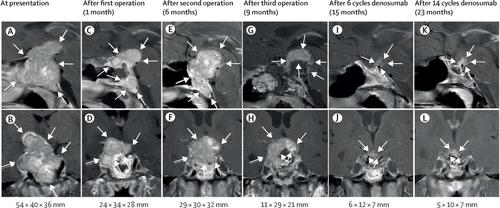当前位置:
X-MOL 学术
›
Lancet Diabetes Endocrinol.
›
论文详情
Our official English website, www.x-mol.net, welcomes your
feedback! (Note: you will need to create a separate account there.)
Denosumab salvage therapy in a patient with a locally advanced and refractory sellar giant cell tumour of bone.
The Lancet Diabetes & Endocrinology ( IF 44.0 ) Pub Date : 2020-02-11 , DOI: 10.1016/s2213-8587(20)30041-3 Pedro Marques 1 , Natasha M Appelman-Dijkstra 1 , Hans Gelderblom 2 , Mark C Kruit 3 , Wouter R van Furth 4 , Alberto M Pereira 1 , Nienke R Biermasz 1
The Lancet Diabetes & Endocrinology ( IF 44.0 ) Pub Date : 2020-02-11 , DOI: 10.1016/s2213-8587(20)30041-3 Pedro Marques 1 , Natasha M Appelman-Dijkstra 1 , Hans Gelderblom 2 , Mark C Kruit 3 , Wouter R van Furth 4 , Alberto M Pereira 1 , Nienke R Biermasz 1
Affiliation

|
A 41-year-old man presented with a 2-month history of progressive vision loss and headaches. MRI revealed a large sellar tumour with suprasellar extension, which was deemed a probable pituitary macroadenoma (). The patient underwent transsphenoidal surgery because of visual field defects and headaches. Histological analysis after surgery revealed a giant cell tumour of bone (GCTB) and symptoms improved; however, 2 months later the large sellar–clival remnant compressing the optic chiasm () motivated a second surgery by pterional craniotomy. After surgery, tumour regrowth occurred (), causing diplopia and blurred vision. A third decompressing operation aiming for maximal debulking before denosumab commencement was done endoscopically; however, only partial tumour removal was achieved (). Denosumab (120 mg subcutaneously every 28 days) was initiated, and a marked response was noted after 6 months of treatment (). After 14 months of denosumab, the patient remained symptom-free without needing further operations ().
中文翻译:

Denosumab挽救疗法用于患有局部晚期难治性蝶鞍巨细胞瘤的患者。
一名41岁的男子有2个月的进行性视力减退和头痛病史。MRI揭示了一个大型的鞍状肿瘤,具有上鞍延伸,被认为是可能的垂体巨腺瘤()。由于视野缺损和头痛,该患者接受了蝶窦手术。手术后的组织学分析显示骨巨细胞瘤(GCTB),症状得到改善;然而,两个月后,巨大的鞍状-腹底残余物压迫了视交叉膜,开始了第二次开颅手术。手术后,发生肿瘤再生长(),引起复视和视力模糊。在内窥镜下开始地诺单抗开始前的第三次减压操作,旨在最大程度地减量化;但是,仅实现了部分肿瘤切除()。开始使用Denosumab(每28天皮下注射120 mg),治疗6个月后观察到明显的反应()。地诺单抗治疗14个月后,患者无症状,无需进一步手术()。
更新日期:2020-03-19
中文翻译:

Denosumab挽救疗法用于患有局部晚期难治性蝶鞍巨细胞瘤的患者。
一名41岁的男子有2个月的进行性视力减退和头痛病史。MRI揭示了一个大型的鞍状肿瘤,具有上鞍延伸,被认为是可能的垂体巨腺瘤()。由于视野缺损和头痛,该患者接受了蝶窦手术。手术后的组织学分析显示骨巨细胞瘤(GCTB),症状得到改善;然而,两个月后,巨大的鞍状-腹底残余物压迫了视交叉膜,开始了第二次开颅手术。手术后,发生肿瘤再生长(),引起复视和视力模糊。在内窥镜下开始地诺单抗开始前的第三次减压操作,旨在最大程度地减量化;但是,仅实现了部分肿瘤切除()。开始使用Denosumab(每28天皮下注射120 mg),治疗6个月后观察到明显的反应()。地诺单抗治疗14个月后,患者无症状,无需进一步手术()。











































 京公网安备 11010802027423号
京公网安备 11010802027423号